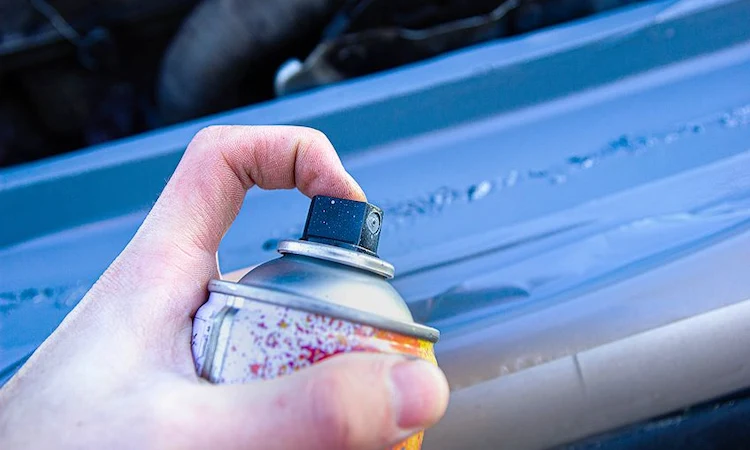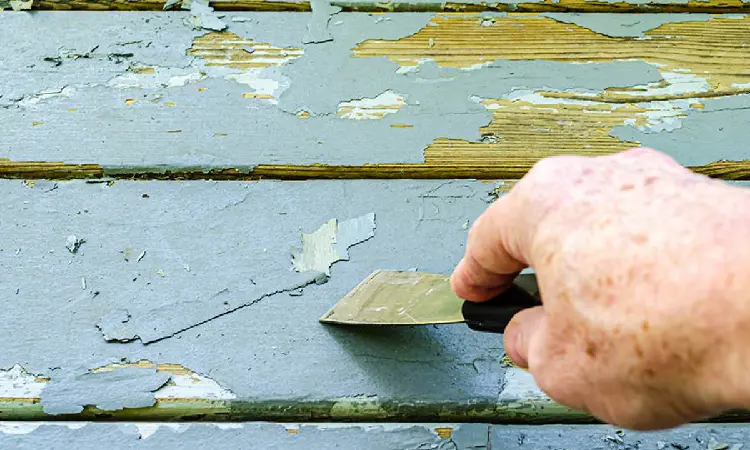Did you use the wrong spray paint? Or was the color not what you were expecting? Or maybe you did not think the spray paint would reach that item in the corner.
Spray paint can be very unpredictable and can get on objects you were not planning on painting.
Luckily for you, spray paint, like any other paint, can be easily removed from plastic surfaces. It is easier to clean it up while it is still wet, but it can be removed once it is dry too.
The process can be tiring and will require a lot of patience. You should know that you could potentially harm the plastic when removing the spray paint.
Plastic can be very thin and frail which is why some precautions should be taken when removing spray paint from plastic.
I recommend you keep reading this article to learn everything you can about how to remove spray paint safely from plastic.

Is Spray Paint Hard to Remove From Plastic?
The process of removing spray paint from plastic is pretty easy.
The only issue is that spray paint and plastic are similar chemicals. What does that have to do with removing the spray paint?
Since they are made of similar chemicals, solvents not only break down the paint but can also break down the plastic.
This makes removing spray paint a sticky situation. It is possible, but it does require some patience and concentration.
What About Dried Spray Paint?
It is easier to remove spray paint while it is still wet, but it can be removed once the paint has dried.
Do not worry if you are removing spray paint that has been there for a couple of hours or paint that has been there for years.
I will help you figure out how to safely and easily remove the spray paint from the plastic. Keep in mind that the longer the spray paint has been there, the more elbow grease you will have to utilize to remove it.
Related Read: How Long Does Spray Paint Take to Dry?
How to Remove Spray Paint From Plastic Without Damaging the Plastic
Solvents are not always necessary to remove spray paint. One of the easiest methods is to use soap and water.
Dish soap can be used to make a solution to remove spray paint from plastic.
Since dish soap is used to cut through grease, it is no surprise that it can also be used to remove spray paint.
This is one of the best solutions when removing a large surface area of paint.
Why do I believe this is one of the best solutions? Because it involves the least amount of chemicals making this solution better for your overall health. Plus, who doesn’t have dish soap in their house?
Materials You Need
- A bucket
- Warm water
- Soap
- Towel or sponge
- Paint scraper
- Dry cloths
Step 1.
You will have to make a solution with 1 gallon of warm water and 3 teaspoons of dish soap. Some people like to add essential oils to their solution to create a nice scent, but it is not necessary.
Use a towel or sponge to soak the area with paint and let it sit for about 20 minutes.
Step 2.
After the paint has soaked in the solution, you can use a plastic putty knife to scrape off the paint.
You should be cautious and scrape the paint at an angle. This will help decrease the risk of scratching the surface of the plastic.
Step 3.
Dry the area with a dry cloth. If there is still paint on the surface, you can repeat the steps above to remove the rest of the paint.
If dish soap does not help, you could try one of the other methods listed later in the article.
Other Household Items You Can Use to Remove Spray Paint From Plastic
Unfortunately, soap and water may not remove all of the paint from the plastic. Several other household items may work better, but that does not always make them the best option.
I will explain why some solutions work better than others later.
If you decide to use one of the cleaners listed below, you should test the cleaner on a small portion of the plastic first.
Plastic can be very delicate, and you never know how it will react to different chemicals.
The household cleaner can be used on a small unnoticeable portion before pouring it over the entire item.
This is the best way for you to see if the cleaner will remove the spray paint without damaging the plastic.
Rubbing Alcohol
99 or 91% rubbing alcohol can easily remove dried spray paint. Rubbing alcohol liquefies dried stains, no matter how old they are.
You do have to be careful when using rubbing alcohol because it does evaporate quickly. I also recommend wearing gloves, as rubbing alcohol can dry out your skin.
You can use a cloth to dab the rubbing alcohol on the surface, or you can pour it directly on the dried spray paint.
Then you can use plastic wrap to cover the object and prevent the rubbing alcohol from evaporating.
After five to ten minutes, you simply use warm water to wash off the paint.
You may need to use a plastic putty knife to remove any small bits of paint that are left. You can also use a rough sponge to scrub off the difficult patches of paint.
Nail Polish Remover
Nail polish remover is not only good for removing paint from nails. It can also remove spray paint from plastic.
Many people have nail polish remover in their house, but it is important to ensure it contains acetone.
Acetone liquifies dried spray paint, making it very easy to remove the paint.
Acetone also works from the top down to remove paint. This helps prevent the underlying plastic from getting ruined.
As the paint lifts from the plastic, you should be able to use a rag with warm water to remove the rest of the paint.
Note that nail polish remover can have a very powerful odor. You should be mindful of how long you work with it. You may even want to wear gloves and a mask when using it.
Vinegar
Vinegar is a staple in most home kitchens, making it easily accessible to remove dried spray paint. Vinegar does need to be warm for it to remove paint from a surface successfully.
Therefore, I would not recommend using vinegar to remove spray paint from plastic.
A warm or hot liquid could damage the plastic by melting it.
If you feel confident in your skills of working quickly or you are working with sturdy and hard plastic, then vinegar may be a good solution to your dilemma.
You can warm up the vinegar in the microwave or on the stove.
The vinegar should be allowed to sit on the plastic for 20 minutes and then rinsed. You can repeat the process until all of the paint is removed.
Oven Cleaner
Oven cleaner is not only used to clean your oven, but it can also be used to remove dried paint. All you have to do is spray the dried paint with the oven cleaner.
Then let it sit for 20 minutes. You should notice the paint begin to crack or bubble up.
You can use your kitchen faucet to remove the oven cleaner. However, an outside hose will work better as it has more water pressure.
If there is still paint remaining on the surface, you can repeat the process.
If you decide to do this project outside, be careful where you spray the oven cleaner. It can kill grass if it is allowed to dry on it.
Cooking Oils
Are you short on cleaning supplies? You can use cooking oils such as olive oil or vegetable oil to remove spray paint from plastic.
This method works very well on oil-based spray paints, but it can work on other paints as well.
You should wear gloves to avoid getting oil all over your hands.
The oil should sit on the object for several minutes this allows the oil to break down the dried spray paint. You can then use a soft brush to scrub the paint away.
When the paint is removed, the plastic can be cleaned with warm water and soap.
You should thoroughly clean the plastic to get all of the oil off of it. Nothing is more frustrating than sitting in an oily chair and getting oil stains on your clothes.
Acetone
Earlier I mentioned acetone in nail polish remover, but now I am speaking of acetone on its own.
Acetone is sold in a metal tin and has a higher concentration than the acetone found in nail polish remover. Pure acetone can remove spray paint, but it can also damage the plastic.
Acetone can easily break down paint, and it does evaporate quickly. If you want to use acetone, you will have to work fast.
The more the plastic is exposed to the acetone, the higher the chances of the acetone damaging it.
This product is flammable and should be used with caution. While acetone is odorless, it can cause poisoning, so it is recommended to use a respirator and be in a well-ventilated room.
You should also wear gloves when using this product to protect your skin.
WD-40
I’m guessing you never thought to use WD-40 to remove paint, and neither did I.
There are many great ways to utilize WD-40 around the house. You can even spray hardware before painting, and the WD-40 will keep paint from adhering to the hardware.
WD-40 has been used to remove graffiti, but you should not use it at home to remove spray paint.
WD-40 can cause damage to the plastic underneath the paint. It is also a harsh chemical and will require you to wear a respirator while using it.
While WD-40 can remove spray paint from plastic, I do not recommend it.
It can do more harm than good to both the plastic and your health. Instead, try using one of the other at-home cleaners to remove the spray paint.
Paint Thinner
In theory, paint thinner can remove spray paint from plastic, but it should be the last resort.
If you have to get the paint off the plastic and nothing else works, you can use paint thinner.
However, you risk causing more damage to the plastic and your health.
Do not use anything higher than 20% paint thinner. You can dilute the paint thinner with water to preserve the plastic underneath.
If that does not remove the spray paint, slowly increase the amount of paint thinner.
You will have to be careful not to overdo the concentration of paint thinner. If you choose to use paint thinner, make sure you have the proper personal protective equipment (PPE).
You should be wearing a mask and gloves while applying the paint thinner. You should also be in a well-ventilated area.
Removing Spray Paint From Plastic: FAQs
Are you ready to tackle that dried spray paint? If you are not and you still have questions, then keep reading.
Even if you feel you know everything there is to know about removing spray paint, you should keep reading as I answer some common questions people may have.
1. How Long Does Spray Paint Stay On Plastic?
Normal spray paint will not last long on plastic. It can begin to bubble and peel within a couple of minutes.
This is good to hear when you did not intentionally spray paint plastic.
However, what if you wanted to spray paint the plastic and want it to last?
Luckily for you, there are spray paints out there specifically designed for plastic. You should use spray paint designed for plastic as it is more likely to bond to the surface.
2. Does Acetone Hurt Plastic?
Acetone can be harmful to plastic. It is probably one of the best solvents to use if you want to remove spray paint from plastic, but it can cause damage to the plastic and your health.
However, it will not damage all forms of plastic.
Some plastic is stronger and more durable than other plastic.
You will decrease the chances of the acetone damaging the plastic if you remove it quickly. You should only apply acetone in small amounts and only apply it to the spray paint.
The acetone found in nail polish remover is safer than acetone on its own. Nail polish remover is sold in a plastic bottle, which means the acetone is not strong enough to destroy plastic.
You should still use caution when using nail polish remover because you never know how the plastic will react.
3. Will Paint Thinner Remove Spray Paint?
A paint thinner can remove spray paint from plastic and other surfaces.
It is a substance that should be used with extreme caution due to the effects it can have on your health.
You should only turn to paint thinner when nothing else has worked, and you are at your wit’s end.
A paint thinner can cause health issues for you. Short-term exposure to paint thinner can make you dizzy and have headaches, nausea, and more. Long-term exposure has more severe consequences.
4. Can Paint Thinner Damage Plastic?
A paint thinner can damage plastic depending on the type of plastic. It is more likely to damage soft plastics than hard plastics.
You should use a diluted paint thinner to reduce the risk of causing damage to the underlying plastic.
Mineral spirits are a more refined version of paint thinner, making it less likely to damage the plastic.
Keep in mind there is a risk of damaging plastic with any household product. You can also dilute the paint thinner, as I mentioned earlier in the article.
Paint thinner should not be allowed to sit on the object. The longer the paint thinner sits, the more it will affect the underlying plastic.
The best option is to scrub the spray paint with a sponge or brush as soon as you apply the mixture.
5. Does Rubbing Alcohol Damage Plastic?
Rubbing alcohol does not damage the plastic. It can strip the paint off of plastic, but it should not damage the plastic.
Rubbing alcohol is a great way to remove paint from items like plastic models.
6. Can You Use a Pressure Washer to Remove Paint from Plastic?
If you have a huge surface area to remove paint, you may want to utilize a pressure washer.
You can and should still use the dish soap solution mentioned at the beginning of this article to soften the paint before trying to remove it with the pressure washer.
You should start with the lowest setting on the pressure washer and work your way up if necessary.
Remember, plastic is very thin and can be easily warped or damaged.
7. Do You Need Any PPE When Removing Spray Paint?
You need PPE when removing spray paint. Even if you are only using dish soap, you should be wearing gloves and, potentially, goggles.
You never know when you will splash soap in your eyes, and many soaps can dry on the hands.
Some of the methods I have mentioned will require masks and possibly respirators. At the bare minimum, you should expect to wear gloves when removing spray paint.
You can read the product’s label to find out what other PPE you may need when using it.
Verdict
There are a variety of products that can safely and easily remove spray paint from plastic.
There are also a lot of products that can damage the plastic in the process of removing the spray paint.
It is easier to remove spray paint when wet, but if you took the time to read this article, the paint is probably dry.
Spray paint that is dry can still be removed. It just requires some more elbow grease and a lot of patience.
Plastic can be very fragile and thin, making it easy to damage when trying to remove paint.
You should use caution and work efficiently when removing the paint. You should not apply heat or use any sharp objects as these will, without a doubt, harm the plastic.
Before using any household cleaner to remove the spray paint, remember to test an area first. You want to know how the solvent will affect the plastic before you cover the whole object in that solvent.
Do not forget to wear your PPE when handling any cleaning projects mentioned in this article. Ideally, you should wear gloves even when using soap and water.
When you scrub an object, it can become very easy to tear your hands up.










